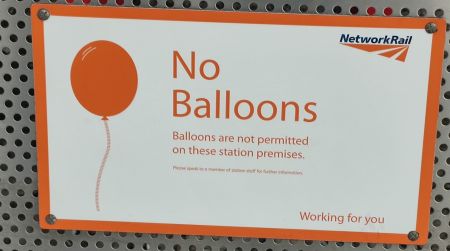No balloons
It is pleasing to imagine the sequence of events that led to the erection, of Liverpool Lime Street station, of the following sign:

|
NO BALLOONS.
Balloons are not permitted on these station premises.
Please speak to a member of station staff for further information.
- Network Rail: Working for you.
Now there are many things you can imagine that the proprietor of a rail terminus might not like brought onto its premises. Some its health & safety team might feel strongly about: Snakes, for example. Crocodiles. Explosives. Undomesticated grazing livestock.
Then there are those which might upset tenants and concession-holders: a rickshaw coffee vendor who cycles in and sets up on the platform concourse. That kind of thing.
Then there those articles which, while posing no immediate danger to life, limb or the profitability of stall-holders, could be disruptive enough to the orderly functioning of the station: megaphones. The playing of cricket. Madrigal groups. Boomerangs. Stink-bombs.
Yet nowhere in the grounds of Liverpool Lime Street will you be cautioned to so much as restrain your alligator. Guerrilla coffee vendors, have, as far as station signage goes, free run of the place. Choral societies, cricketers and those with loud-hailers may carry on as they please — at least, we suppose, until asked to stop.
But should a young nipper skip across the platform with his balloon-dog, he risks immediate censure. True: the sign does not go so far as to say what form that censure will take. Would he be arrested? Marched to a cashpoint and ordered to pay an on-the-spot fine? The JC did not wait around long enough to find out. But we did notice the uneasy looks of local urchins as they milled around the station, clutching their R&B 45s, earned from rough trade with itinerant American seamen. They did not seem minded to run the gamut. This is out of character.
Somehow, in Liverpool the humble balloon has earned its own special category of turpitude. What can have happened? Was the fat controller one day plagued by balloons, flipped out and decided to get his own back? Has it helped?
Signs
The JC doesn’t like the sorts of signs that warn you, or forbid you, or tell you what you can or cannot do. They emanate from the same passive aggressive instinct as the email sent from an unmonitored account — they’re a cheap shot at someone who can’t hit back — and more to the point they are a failure in design: if you don’t people to walk on your grass, stick up a fence, or pave the damn thing, or create some obstacle — do with life code what you are trying to do with bossiness.
So some thoughts about notices, which we will arbitrarily define as written directions to do, or refrain from doing, something.
If in doubt, use design principles to avoid signs
Most signs — other than the exception of directions, and signposts, don’t work very well. They suggest you have failed in your task of designing your space. The language of design: affordances, signifiers, mapping and feedback — Don Norman’s The Design of Everyday Things can tell you what you need to know about these — can help, but your goal should be psychological. If you have designed your space well, then — with the exception of signposts — you shouldn’t need signs
If you really can’t have people walking on your grass, build a fence. But if you are building a grassed area where people walk by, ask why. Use a hardier grass seed. But if you are just being an officious twerp because it is your property and you can, well — don’t.
Where signs are okay
in some cases we won't mind signs. They’re part of the design: they impart vital information and there's no better way of transmitting it. Signs that help you figure out what you want, and it can’t otherwise be made obvious through design and affordance. Maps, menus and street signs, for example. There's only one way of being sure I’m on Oxford Street, and that’s sign saying it. Likewise it is good to know that this is the turn-iff for Stansted: the M11 is a long motorway and it has lots of exits, and there's no easier way of intuitively knowing. And a menu: well how am I supposed to know what's on your menu without, well, a menu? But here be brief, clear — monosyllabic.
Likewise, where a condition is temporary enough that a redesign of the space is not practicable: So: “closed for maintenance”, or “thank-you for wearing a mask and maintaining social distancing”.